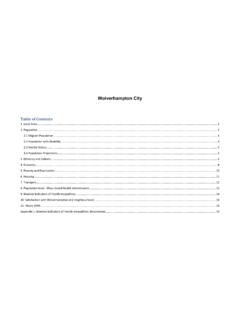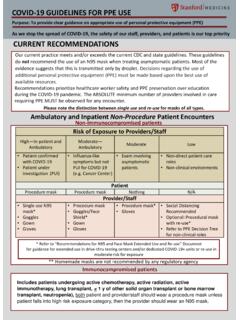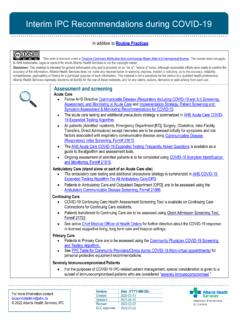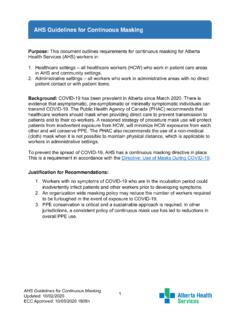Transcription of Aerosol Generating Procedures (AGPs) Basic Information
1 Aerosol Generating Procedures (AGPs) Basic Information What are AGPs and why is there different Personal Protective Equipment (PPE) for them? COVID-19 is spread predominantly by droplets. PPE used to prevent droplets includes surgical masks. However, some activities, known as Aerosol Generating Procedures , allow the COVID virus to get into smaller particles which stay in the air longer and which need to have a mask which is fitted to your face, and which has extremely small holes, to prevent. These masks (technically they are called respirators are called FFP3 level, and where these aren't available, they are FFP2 level. Where AGP PPE is worn, you would wear: An FFP3 (or possibly FFP2 FFP3 is preferred) respirator mask A gown or coverall Gloves Face protection Guidelines change, but where there is a risk that the person you are performing an AGP for has the COVID virus, the recommendation is to wear AGP PPE for the duration of the risk, with the activity happening in a room away from any other people, with a closed door, which is ventilated with at least an open window and which will be cleaned appropriately afterwards.)
2 AGPs include: Intubation, extubation and related Procedures , for example, manual ventilation and open suctioning of the respiratory tract (including the upper respiratory tract1). tracheotomy or tracheostomy Procedures (insertion or open suctioning or removal). bronchoscopy and upper ENT airway Procedures that involve suctioning upper gastro-intestinal endoscopy where there is open suctioning of the upper respiratory tract surgery and post mortem Procedures involving high-speed devices some dental Procedures (for example, high-speed drilling). non-invasive ventilation (NIV); Bi-level Positive Airway Pressure Ventilation (BiPAP) and Continuous Positive Airway Pressure Ventilation (CPAP)2.
3 High Frequency Oscillatory Ventilation (HFOV). Induction of sputum high flow nasal oxygen (HFNO)3. potentially: cough assist Procedures Fit Testing It is essential that the specific model of FFP2 or FFP3 mask that you are wearing has been fitted to your face with a fit test , if you are using it for an AGP. 1. This includes suctioning saliva from a person's mouth 2. These activities are AGPs for the duration that the NIV is used 3. This is NOT standard oxygen by nasal cannulae eg. at 2 litres/minute The process of face fit testing ensures that the respirator which you wear will protect you from the hazardous droplets, aerosols, dusts, mists and vapours to which you are potentially exposed during your working day.
4 The test will ensure that the seal between the respirator and your face remains tight, particularly when moving and talking, to ensure that no leakages occur. On successfully completing the test, you will be assured that the mask fitted will protect you as intended. A fit test . is where a person fits the mask with you, and introduces a harmless Aerosol into a hood which you wear over your head during the test. You will then be asked to perform a few different breathing, talking and movement activities. The whole test takes a approximately 20 minutes. If you are able to taste the Aerosol introduced into the hood then the model of mask is not correct for your face and you should not perform AGPs with that mask.
5 In Wolverhampton, fit testing is often performed by either the Infection Prevention team at New Cross Hospital or the Council's Health and Safety department, but you may have links into other fit testing services. If you change the model of FFP3 or FFP2 mask, then it is essential that your staff get new fit testing done. What is the Basic difference in the PPE worn for AGPs and non AGPs? Please refer to national or regional guidance for more Information about exactly which components of PPE are needed in which situations: control/covid-19-personal-protective-equ ipment-ppe#scope-and-purpose Alternatively, social care teams and public health at the council will be able to answer queries.
6 Where can I find more Information about putting on and taking off PPE for AGPs? All staff need to be competent in putting on and taking off PPE, and aware of safety precautions while wearing it. It is your duty as an employer to ensure your staff are competent in these things. Please familiarise yourself and your staff with the material below which is specifically for AGP PPE: Aerosol - Generating - Procedures















